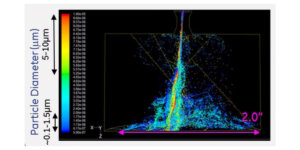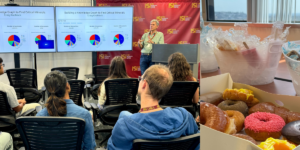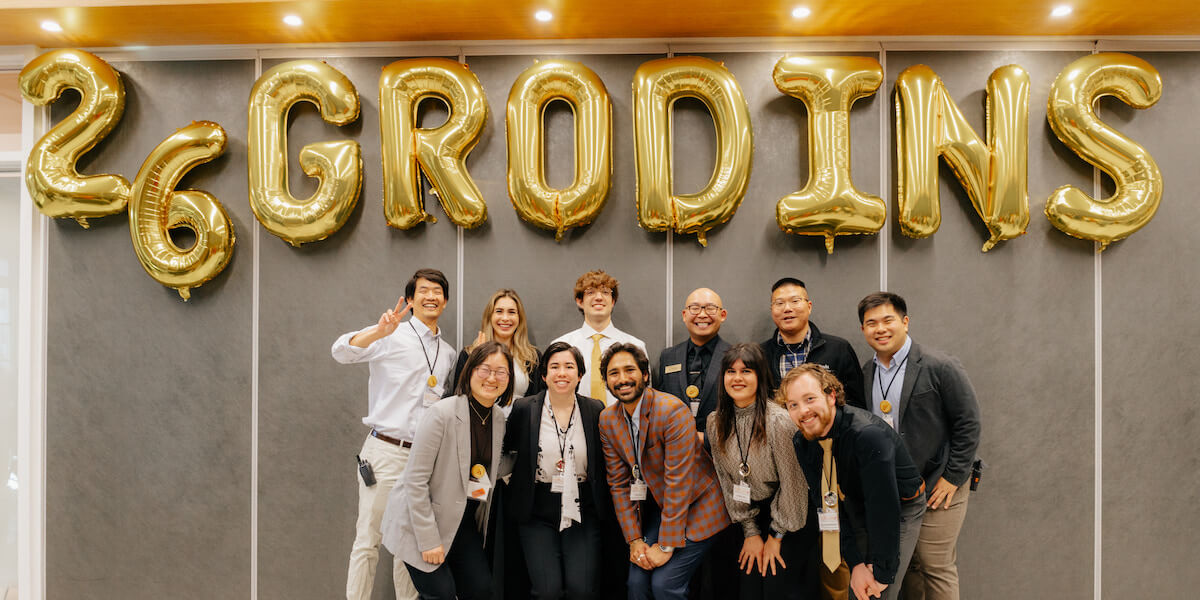
The 2024 Grodins Symposium celebrated the breadth of Ph.D. student research across the Alfred E. Mann Department of Biomedical Engineering. Image/Frank Ding
From cutting-edge neural probes to T-cell targeting nanoparticles, the 2024 Fred S. Grodins Symposium shone a spotlight on the future of biomedical engineering student research at the University of Southern California.
Hundreds gathered at the USC Michelson Center for Convergent Bioscience for the 26th-anniversary event, which was organized entirely by a committee of students in the Alfred E. Mann Department of Biomedical Engineering.
Visitors took part in poster sessions, podium presentations and industry networking, as the latest Ph.D. student research from biomedical engineering labs at USC was highlighted. The day also featured career panels, which offered students key insights into biomedical engineering career possibilities spanning industry and academia.
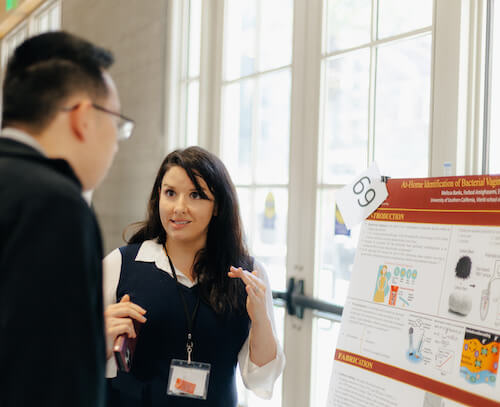
Ph.D. student in the Laboratory for Design of Medical and Analytical Devices, Melissa Banks, during the Grodins poster presentations. Image Frank Ding.
The event kicked off with a keynote presentation from Ki Chon, USC alum and current Krenicki Professor of Biomedical Engineering at the University of Connecticut. Chon’s presentation examined the problem of treating decompression sickness and the mitigation of central nervous system oxygen toxicity risks posed by treatment with hyperbaric oxygen prebreathing. Chon presented a wearable sensor approach using electrodermal activity (EDA) and machine learning to predict seizures in patients.
Organizational committee executive chair James Eichenbaum, a research student in the McCain Lab, said that the biggest highlight of the day was witnessing the increased participation from across the department.
“We had a great turnout from faculty, post-doctoral researchers, undergraduate students and design teams, and even new master’s students. It was truly a department-wide event,” Eichenbaum said. “The most rewarding aspect of leading the planning team for the Grodins Symposium was seeing it all come together. It’s a huge undertaking, but the entire student team worked incredibly hard, and it was amazing to see the positive feedback from everyone who attended.”
Eichenbaum said that the students had also received valuable support from staff, post-docs and faculty who volunteered their time.
“Ultimately, the success of the symposium is a testament to the collective effort of the entire department. It was a truly collaborative event that achieved our vision of bringing everyone together to celebrate research and foster a stronger sense of community within biomedical engineering,” Eichenbaum said.
Brain imaging research wins podium award
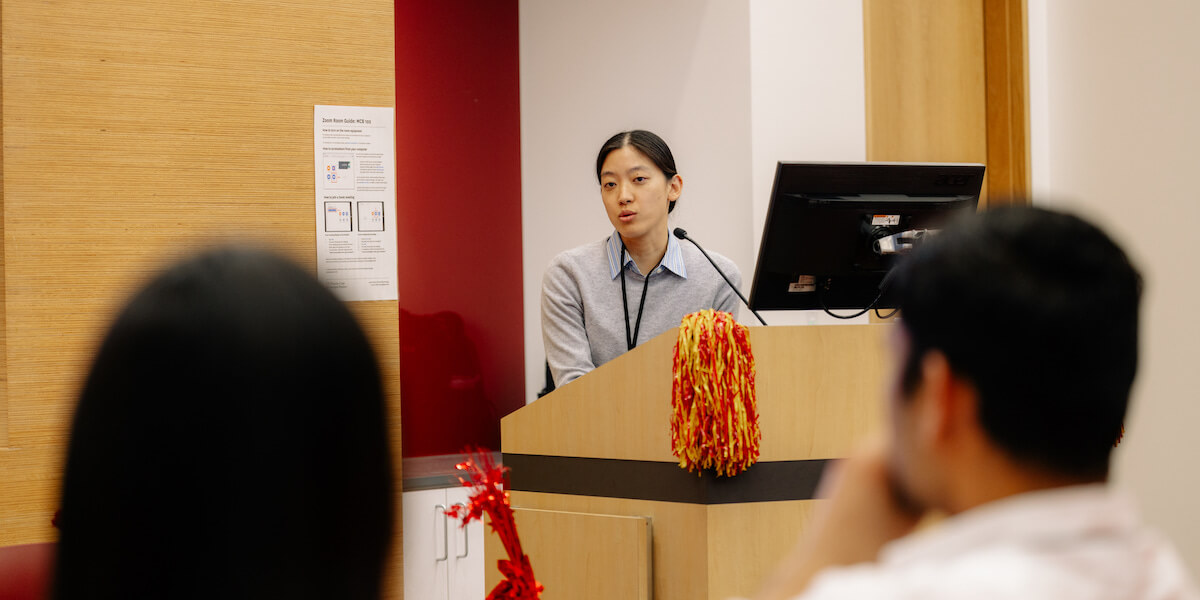
Alyssa Zhu delivered the podium prize-winning presentation about how big data can be harnessed in brain MRI studies. Image/Frank Ding
The 2024 Grodins prize for best podium presentation went to Alyssa Zhu, a BME Ph.D. student working in the Laboratory of Brain eScience led by Associate Professor of Neurology and Biomedical Engineering Neda Jahanshad.
Zhu’s research focuses on using big data in brain MRI studies to improve the understanding of the changes a brain can undergo because of disease or aging. Her winning podium presentation was titled “Reference Curves For Harmonizing Multi-Site Regional Diffusion MRI Metrics Across The Lifespan.”
Zhu said that brain imaging studies often focused only on developmental or aging periods of life but rarely covered the whole lifespan.
“One idea is to merge many different and smaller studies to really be able to understand the full course of brain changes throughout life. Unfortunately, the complexities of MRI, especially diffusion MRI, which allows us to assess the brain’s white matter, have made it difficult to pool data and to create standardized measures between scanners,” Zhu said. “Our goal was to create lifespan reference curves for white matter in the brain that could be used to gauge how someone of a particular age and sex compares to their peers, similar to standardized growth charts (height and weight) for babies and children.”
Zhu was grateful for the podium award, saying that a highlight of the symposium was being able to connect with others about her work following her presentation.
“The podium prize was a very unexpected but gratifying surprise,” Zhu said. “All in all, it’s very rewarding to know people have the same enthusiasm for your research that you do.”
The full list of Grodins Symposium award winners
Stevens Center for Innovation’s Most Disruptive Award: Mher Garibyan — Activating Synthetic Notch Receptors by a Patterned Surface for Spatial Control of Tissue Differentiation
Stevens Center for Innovation’s Most Commercial Potential Award: Brianna Thielen — A Novel Thin Film Endovascular Electrode Array for Minimally-Invasive Neural Recording
Best First Year Poster Award: Karla Lambaren — Engineering T Cell Targeting Nanoparticles to Modulate Immune Response in Hypertension
Best Posters: Advanced Imaging, Spectroscopy, and Analysis
1st Place: Yangyang Bai— A Versatile Fourier Light Field Microscope Platform for Fast Multi-purpose 4D Bio-imaging
2nd Place: Sean Burkitt — Label-Free Visualization and Analysis of Nanoparticle Biodistribution Using Multiphoton Luminescence
3rd Place: Shanshan Cai — Multiplexed diffused optical imaging Generative Adversarial Network (mDOI-GAN) for Sub-surface 3D Imaging of Tissues
Best Posters: Nanomedicine, Cellular Therapies and Engineered Tissues
1st Place: Anisa Ashraf — MicroRNA-145 Micelles for Reverting Endothelium Activation and Monocyte Recruitment in Atherosclerosis
2nd Place: Alisa Peshina — Regulation of Engineered Human Myometrial Tissue Contractility by Mechanical Stretch
3rd Place: Cem Kilic — CARTIA: a functional screening platform for engineering the next generation of CAR T-cells against hypoxic solid tumors
Best Posters: Next-Generation MRI
1st Place: Shayan Javid — Data-driven Subtyping of Individuals on the Alzheimer’s Continuum Using Cortical Microstructure from dMRI
2nd Place: Pengcheng Wang — Abdominal Organ Segmentation of Magnetic Resonance Imaging based on Swin Transformer
3rd Place: Parsa Razmara — Advancements in Prostate Luminal Water Imaging: Enhancing Diagnostic Precision through Radial Turbo Spin-Echo Acquisition and Spatial Regularization
Best Posters: Novel Diagnostic and Patient Monitoring Techniques
1st Place (tied): Farbod Amirghasemi — Flexible Neural Probe For The Selective In-Vivo Recording of Acetylcholine
Ruitong Chen — A Thin Film Wireless Biomarker Sensing System Based on Reflected Impedance
2nd Place: Christopher Larson — Materials Characterization for Microneedle-Based Molecular Sensing Platform
3rd Place: Mellisa Banks — At-Home Identification of Bacterial Vaginosis using Low-Cost Electrochemical Sensor
Best Posters: Signals, Systems, and Modeling
1st Place: Lynne Cherchia — Integrating Mechanistic Modeling and Quantitative Imaging to Reveal Pancreatic Beta Cell Signaling
2nd Place: Xiecheng Shao — Deciphering Neural Dynamics: LSTM Networks and Gamma Band Modulation in Movement Analysis
3rd Place: Bryan Moore — Deep Multi-input Multi-output Model of Spike Train Transformation
Best Podium Presentations
1st Place: Alyssa Zhu — Reference Curves For Harmonizing Multi-Site Regional Diffusion MRI Metrics Across The Lifespan
2nd Place: Jeong Oh — Overcoming Hypoxia-Mediated CAR-NK Therapy Resistance in a 3D Glioblastoma Model
3rd Place: Antonina Maxey — Engineering Human Myometrium to Evaluate the Contractile Effects of Inflammatory Mediators
Published on April 1st, 2024
Last updated on April 4th, 2024




